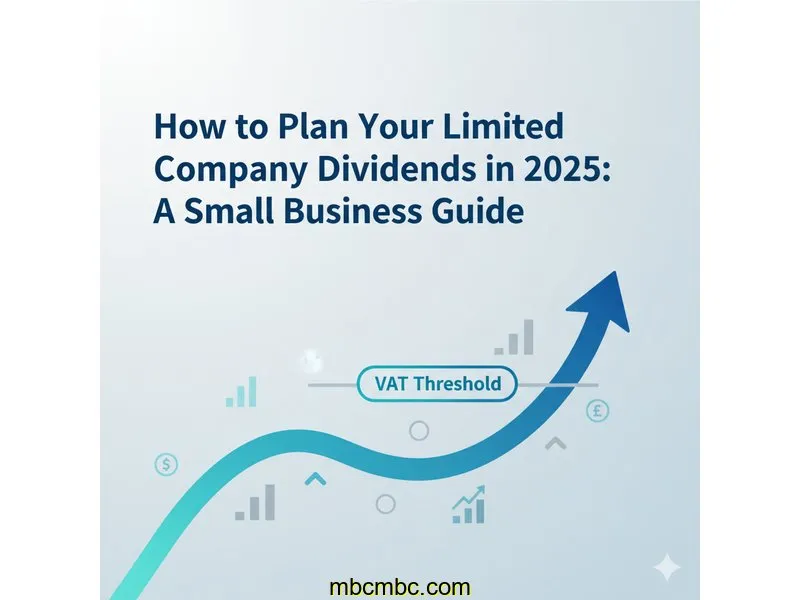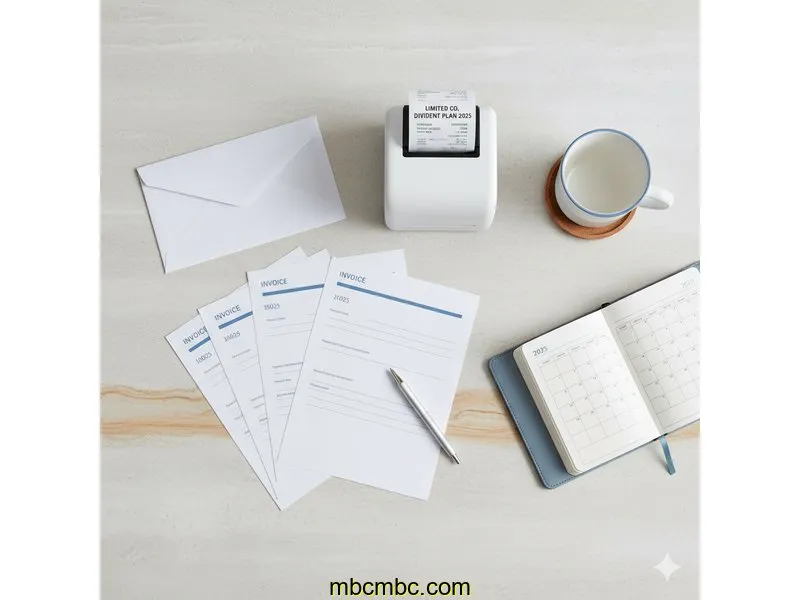
Hi, I'm Alex Williams, founder of FinTools UK. As a developer, I love breaking down complex financial topics. One of the most common areas of confusion for new limited company directors is figuring out dividends. It's not just "taking money out" of your business; it's a formal process with its own set of taxes and rules.
Running a small business is a constant balancing act, and understanding how you pay yourself is perhaps the most important part. With recent changes slashing the tax-free dividend allowance, planning *how* and *when* you take dividends is more critical than ever for the 2024/25 and upcoming 2025/26 tax years.
This guide is designed to explain the mechanics of dividend tax, show you what's changed, and help you understand how to plan your income. Please note, this is for informational purposes only. I'm not a financial advisor, and you should always consult with a qualified accountant for advice specific to your business.
Quick Summary: Dividend Tax Essentials
- What is a Dividend? A dividend is a payment a company makes to its shareholders (you, the director) out of its post-tax profits.
- Key Difference: A salary is a business expense (deducted *before* Corporation Tax), while a dividend is a distribution of profit (*after* Corporation Tax).
- The Big Change: The tax-free Dividend Allowance for the 2024/25 tax year is just £500. This is down from £1,000 in 2023/24 and £2,000 before that.
- How Tax is Calculated: Dividend tax is "stacked" on top of your other income (like your salary) to determine which tax band it falls into.
- The 2025/26 Rates: 8.75% (Basic Rate), 33.75% (Higher Rate), and 39.35% (Additional Rate).
Salary vs. Dividend: A Simple Analogy
Think of your limited company as a bakery.
- Your Salary (PAYE) is the wage you pay yourself for the work of baking the bread. It's a running cost of the bakery, just like flour or electricity. This cost is deducted from the bakery's income *before* the tax man calculates the bakery's profit.
- A Dividend is what you take *after* the bakery has sold all its bread, paid all its costs (including your salary), and paid its own Corporation Tax on the profits. It's your share of the remaining profit as the bakery's owner.
This is why many directors take a small, tax-efficient salary (often up to the National Insurance threshold) and take the rest of their income as dividends. The salary is an allowable expense that reduces the company's Corporation Tax bill, while dividends are generally taxed at a lower personal rate than a larger salary would be.
The Squeezed Allowance: Why £500 Changes Everything
The most significant recent change is the reduction of the tax-free Dividend Allowance. This isn't a separate pot of money; it just means the first £500 of your dividends in a tax year aren't taxed, regardless of your tax band.
Just a few years ago, this allowance was £2,000. This meant a director could take a £12,570 salary (tax-free via the Personal Allowance) and a £2,000 dividend (tax-free via the Dividend Allowance) for a total tax-free income of £14,570.
As of the 2024/25 tax year (and set to continue for 2025/26), that tax-free dividend portion is only £500. This means that £1,500 of dividends that were previously tax-free are now taxed at your dividend tax rate. This makes careful planning much more important.
Here is a simple breakdown of how the tax-free allowances have changed, showing why planning is more critical now.
| Allowance Type | 2022/23 Tax Year | 2024/25 & 2025/26 Tax Year |
|---|---|---|
| Personal Allowance (for Salary/Income) | £12,570 | £12,570 (Frozen) |
| Tax-Free Dividend Allowance | £2,000 | £500 |
| Max. Tax-Free Combination (Salary + Div) | £14,570 | £13,070 |
| Impact | First £2,000 of dividends had 0% tax. | Only the first £500 of dividends have 0% tax. |
How Dividends "Stack" On Top of Your Income
This is the part that confuses most people. Your dividend tax rate isn't calculated in isolation. It depends on your *total* income.
Imagine your income bands as buckets to fill up (for the 2025/26 tax year):
- Bucket 1: Personal Allowance (up to £12,570). You fill this first, usually with your director's salary. Income here is 0% taxed.
- Bucket 2: Basic Rate (£12,571 to £50,270). Your dividends "stack" on top of your salary. So, if your salary is £12,570, your dividends start getting added from this point.
- The first £500 of dividends use your Dividend Allowance (0% tax).
- The *rest* of your dividends in this bucket are taxed at 8.75%.
- Bucket 3: Higher Rate (£50,271 to £125,140). Once your *combined* salary and dividends push you over the £50,270 threshold, any dividends in this bucket are taxed at 33.75%.
- Bucket 4: Additional Rate (Over £125,140). Any dividends in this top bucket are taxed at 39.35%. (Note: your Personal Allowance starts to taper away after £100,000).
So, if you take a £12,570 salary and £40,000 in dividends, your total income is £52,570. The last £2,300 of those dividends (£52,570 - £50,270) will be taxed at the higher 33.75% rate, not the 8.75% rate. This is the "tipping point" that planning helps you manage.
How Calculators Help You Plan
This is where tools become so valuable. It's one thing to read the theory, but another to see your own numbers. A good UK dividend tax calculator can help you model these scenarios visually.
Instead of guessing, you can input your salary and then "test" different dividend amounts. A calculator can instantly show you:
- Exactly how much of your dividend will be taxed at 8.75%.
- At what point you'll tip over into the 33.75% higher rate band.
- What your total, combined tax bill (Income Tax, National Insurance, and Dividend Tax) will be.
- Your final "take-home" pay after all taxes are accounted for.
This allows you to make an informed plan. For example, you might see that taking an extra £2,000 in dividends in March would push you into the higher rate, so you might decide to delay that payment until the new tax year starts in April. This is what "planning" means in practice: using the numbers to make strategic decisions.
Common Questions About Dividend Planning

When researching this topic, I see the same real-world questions pop up time and again on forums. Here are answers to a few common ones.
As a director, is it better to take a small salary and dividends, or just all dividends?
Most accountants suggest a common strategy: pay yourself a salary up to the National Insurance (NI) threshold. For 2025/26, this is £12,570. This salary uses your 0% tax Personal Allowance, and because it's at the threshold, it typically incurs no NI for you or the company, but still qualifies you for State Pension credits. You then take any further income as dividends, which are taxed at the lower dividend rates and don't attract NI. Taking *only* dividends is unusual as you would "waste" your tax-free Personal Allowance.
How do dividends push me into a higher tax bracket? Is the tax *on top* of my income tax?
They don't add to your *income tax*, but they do use up your income tax bands. As explained in the "stacking" section, your salary fills your tax-free and basic-rate bands first. Your dividends are then stacked on top. If your salary is £40,000, your basic-rate band is mostly used up. When you add, say, £15,000 in dividends, the first £10,270 fills the rest of your basic band (taxed at 8.75%, after the £500 allowance), and the remaining £4,730 falls into the higher-rate band, getting taxed at 33.75%.
When do I pay tax: when the dividend is declared or when I transfer the money?
This is a crucial distinction. The "tax point" is the date the dividend is *paid* or "made available" to you. For a small business, this is typically the date you hold a board meeting (even if it's just you) and sign a dividend voucher or board minute *declaring* the dividend. The tax is due for the tax year in which this date falls, *not* the date you actually transfer the cash from the business account to your personal one. This is vital for end-of-year tax planning.
Final Thoughts
The days of the £2,000 tax-free dividend buffer are gone. The new £500 allowance means that almost every director taking dividends will be paying some amount of dividend tax. Understanding how this tax is calculated, how it stacks with your salary, and when it becomes due is the key to running your business efficiently and avoiding a surprise bill from HMRC.
I hope this guide has helped demystify the process. My goal with FinTools UK is to provide the tools and information to help you see these numbers clearly. This article is for informational purposes, and I strongly recommend speaking with a qualified accountant to create a tax plan that is perfect for your specific business needs.

